With nearly 12 years of service under its belt, the Next Generation 737 is still going strong with almost 3,000 aircraft delivered, although customers are signalling a demand for Boeing to deliver greater efficiency gains.
Boeing's immediate response is incremental improvements in performance and a new aircraft interior.
Starting in mid-2011, Boeing will introduce a package of improvements that it hopes will deliver about 2% improvement in fuel burn for customers flying long stages.
The manufacturer plans to introduce the CFM56-7B Evolution powerplant to deliver a 1% improvement in overall aircraft efficiency. Boeing will also make minor tweaks to the aerodynamics of the aircraft to contribute to a 1% improvement as well.
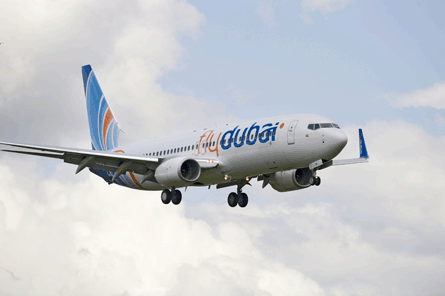 |
|---|
© FlyDubai |
"That's very significant economically, often the difference between making a profit and not making a profit is 1-2%," says Mark Bergsrud, senior vice-president for marketing programmes for Continental Airlines.
CFM will deliver the improvement by reshaping the blades and vanes of the high- and low-pressure turbines to increase airflow through the engine and reducing overall temperature, says director of CFM56 Boeing programmes Robyn Brands.
Boeing and CFM will introduce changes to the engine nozzle and plug, and remove about 9% of engine aerofoils from the high- and low-pressure turbines to reduce maintenance costs by up to 4%.
Aerodynamic changes to the aircraft include a reshaped anti-collision light, refined wing control surfaces, revised main landing-gear wheel-well fairing and a modulation of the environmental control system inlet and exhaust.
In addition to the performance enhancements, Boeing now offers its 737 Sky Interior. This features new colour-LED lighting, larger 777/787-style pivot bins, new sculpted sidewalls, revised window design, a flight attendant touchscreen panel and changes to the individual passenger reading-light panel.
Boeing also hopes to deliver a 2-4dB reduction in cabin noise. The interior improvements mark the most significant change to the 737NG cabin since its introduction with Southwest Airlines in 1998.
The weight-neutral interior will be a priced option for existing 737 customers and be a mandatory priced "option" for new customers.
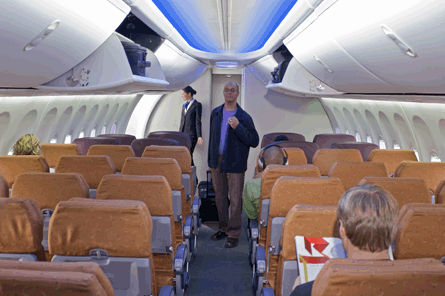 |
|---|
© Boeing |
When Boeing announced the 737 enhancements on 28 April, seven airline launches were unveiled. New 737 operator FlyDubai will be the first to take delivery of the new interior in the fourth quarter of 2010, with Continental Airlines, Norwegian Air Shuttle, Malaysia Airlines, Tui, Gol, and Lion Air to follow as worldwide launch customers.
Boeing's largest 737 customer, Southwest Airlines, reacted coolly to the new enhancements.
The carrier's chief operating officer Mike van de Ven in April reiterated its desire for an major step change to Flight International's sister publication Commercial Aviation Online. While "appreciative of any enhancements that improve operating economics", the airline urgently wanted to see "more game-changing innovation" of aircraft design.
"That type of innovation will require active participation with partners - specifically engine and airframe manufacturers - to achieve the technology breakthrough that improves aircraft economics in at least the 20% range," he said.
Boeing says a 737 replacement is unlikely before 2018-20, with some industry observers thinking it could be even later, but Van de Ven is calling for "an accelerated timeline" for such an aircraft. "Narrowbody operators simply cannot sit and wait another 10-15 years for these types of improvements without some real near-term interim steps in that direction," he says. "If re-engineering the existing airframe is a viable option that can be accomplished on a much quicker timeline, that is something that should at least be considered."
| SEPTEMBER DEADLINE FOR EVOLUTION CFM INTERNATIONAL'S first Evolution engine will be ready in September. CFM says it is already testing Boeing's engine nozzle improvements at its Peebles, Ohio facility. Tests will include 150h of block trials, starting in January, that will see the engine run at maximum core speed, maximum fan speed and maximum operating temperature simultaneously - also known as triple redline - for 30h intervals. Following each continuous 30h triple redline run, the engine will be spooled down, not shut down, then operated again under the same conditions for a total of five 30h triple redline runs. The company adds that if an engine were to achieve triple redline in service for even 20s, the US Federal Aviation Administration would require the operator to remove and overhaul it, emphasising the brutal testing to which the new Evolution engine will undergo. CFM will flight-test the Evolution on General Electric's Boeing 747-100 testbed in February 2010, ahead of a joint US and European certification in July 2010. Once certificated, the Evolution will be branded as the CFM56-7BE. Boeing will use a Continental 737-800 to flight-test the changes in October 2010 ahead of certification and service entry in 2011 - when Boeing's planned aerodynamic enhancements are also scheduled for introduction. |
Southwest, whose 737s seat between 122 and 137 passengers, is not the only customer pushing both Airbus and Boeing to develop a new narrowbody offering.
Airlines are openly expressing their desire to see new narrowbody products that span the 120-seat market all the way up to 200 seats.
US Airways has begun pushing the manufacturers for a replacement to the larger Boeing 757-200, which the carrier uses extensively on international routes.
"We have asked both manufacturers to design a replacement, although that could be years away," says Andrew Nocella, senior-vice president marketing and planning for US Airways.
In addition, KLM has already sent out a request for information on 100 aircraft for replacement, engaging proactively with Airbus and Boeing.
"We sent out a tender for 100 aircraft - it can be easily more. We want to know now exactly what will be the most likely delivery dates of these aircraft and a little bit more about the final specifications. Both sides are delaying, delaying, delaying. Now we want to have clarity," says KLM chief executive Peter Hartman.
For Boeing, the market continues to look solid for its venerable narrowbody as it passes the 6,000th delivery, and production rates that the company believes were strategically built to weather downturns continue to deliver stability in an unpredictable marketplace.
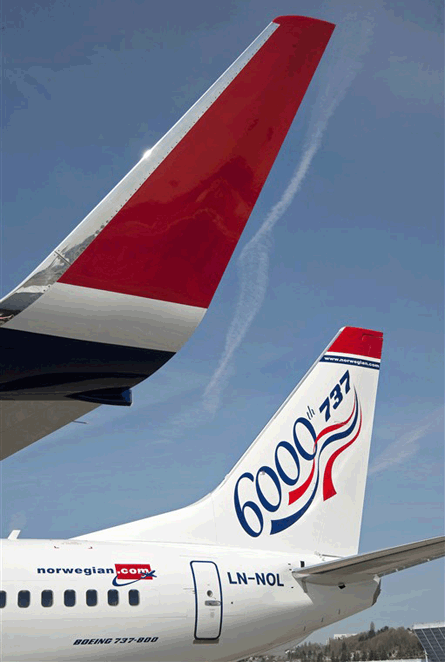 |
|---|
© Boeing |
"I remain cautiously optimistic that we have the ability to build through this cycle on the 737 airplane. We continue to manage it aggressively, we continue to respond to customers requests for adjustments in schedule and to backfill any of those adjustments with pent-up demand for the product. We think that will work and we remain committed to that course," says Scott Carson, head of Boeing Commercial Airplanes.
Despite calls for greater gains in efficiency from airlines, one aerospace analyst believes Airbus and Boeing are inherently distracted from being locked in to a game of chicken in the narrowbody market.
Ron Epstein, analyst for Bank of America/Merrill Lynch, says Boeing remains tied up with the 787 and 747-8, while Airbus is focused on flying the A400M, achieving A380 production stability and pushing the A350 into its final design. Research and development money, as Epstein sees it, is not being put towards the narrowbody products in any significant quantity.
REFINING THE A320
Airbus executives view Boeing's 737 refresh package more as a catch-up for their rival than a serious move to step beyond the A320 family.
"The new 737 cabin looks very nice, but it doesn't have the extra 7in [18cm] in cabin width of the A320 and cannot offer the level of flexibility and adaptability that we have," says A320 family product marketing director Stuart Mann. He is also hopeful Airbus can benefit from any engine improvements Boeing has rung out of the CFM International CFM56.
This year marks the 21st anniversary of the fly-by-wire narrowbody's service debut with Air France and British Airways. The 4,000th delivery is due in July and the 2,400 aircraft on backlog represent over six years of production.
 |
|---|
© Airbus |
With Airbus confident that it will keep the A320 models rolling out of its factories for another decade and deliver at least 8,000 aircraft, there has been no let-up in its product improvement effort. A lighter, quieter cabin design was introduced in 2007, which is being supplemented by ongoing airframe weight-saving effort that is expected to trim 250kg (550lb) off A320s delivered from 2010.
An aerodynamic clean-up of areas such as the pylon and belly fairing means that A320s delivered from January 2009 have a 1% improvement in drag standard, says Mann. "That means reducing our fuel burn and, of course, has beneficial effect on emissions and the environment."
A significant A320 development that has just received approval is an optional 1t increase in maximum take-off weight from a software upgrade to the flight-control system, which is retrofitable to aircraft that are up to around seven years of age.
"We've incorporated a newly designed load alleviation function in the fly-by-wire software which has allowed us to add a 1t take-off weight increase with no structural changes," says Mann. "That means there is no empty weight increase and no maintenance cost increase."
The software uses the flight controls to reduce the wing bending moment, which allows the aircraft to operate at higher loads. Initial approval is for the International Aero Engines V2500-powered version, as this is the variant operated by the upgrade's launch customer US carrier JetBlue. Approval for the CFM56 variant is to follow. The higher weight provides around 280km (150nm) additional range or a payload increase equivalent to 10 passengers.
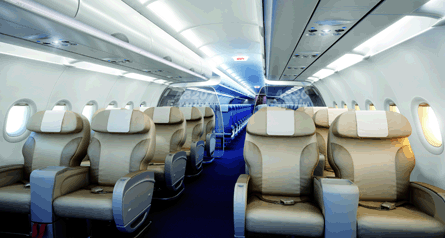 |
|---|
© Airbus |
Mann says the modification, which requires a software upgrade to the elevator and aileron control computer, can be applied to A320s from MSN1903 (a 2002 delivered aircraft), which is the first to incorporate a required structural reinforcement of the horizontal stabiliser.
Another recent initiative has been Airbus's "extended service goal" programme that should see a trebling in airframe fatigue life approved in October 2012. "We are also further extending the maintenance intervals on the aircraft to reduce costs," says Mann.
Like its US rival, Airbus has made use of improvements developed by its engine suppliers. The upgrades - CFM's Tech Insertion and IAE's SelectOne - offer slight improvements in fuel burn, on-wing time and maintenance costs.
But Boeing has raised the bar again, following the agreement with CFM to introduce its "Evolution" upgrade on the 737's CFM56-7 engine, and Airbus has already began talks to see if it can leverage any improvements for the A320's CFM56-5.
"We're talking with CFM. We must get a clear view of what's transferable, what percentage will come across," says Mann. He adds that the earliest impressions suggest Airbus could use "about half the advantages" of the Evolution engine in the CFM56-5, primarily from the core area.
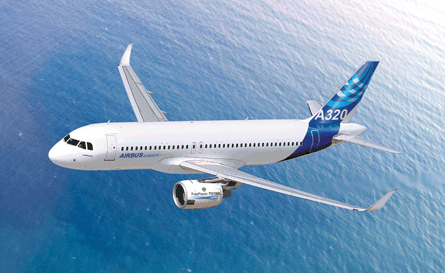 |
|---|
© Airbus/Tim Bicheno-Brown |
Despite Airbus's long-running interest in Pratt & Whitney's GTF geared turbofan demonstrator, which included a flight evaluation last year, Mann plays down the likelihood of a GTF-powered A320 development. "We're still working with P&W to understand the results [of the flight-test], but we do not have a programme to install the engine on the A320," he says, adding that the GTF test was part of Airbus's research into potential engine technology for the next single-aisle family.
Possibly one of the most innovative uses of an A320 family member will begin later this year when British Airways inaugurates transatlantic services from London City airport to New York with an A318.
"It was a challenge getting approval to operate into London City," says Mann. "We have a button in the overhead panel which changes the flight controls to allow the aircraft to have a different aerodynamic braking system as it lands. It also changes all the call-outs with a 'standby, standby, flare' to ease the landing process."
Although it completed another round of winglet test flights earlier this year - this time of a design developed by Aviation Partners - Airbus is yet to decide whether to pursue a programme. "We're evaluating what we've learnt and to define a programme going forward," Mann says, adding that a conclusion should be reached in the near future.
Source: Flight Daily News























